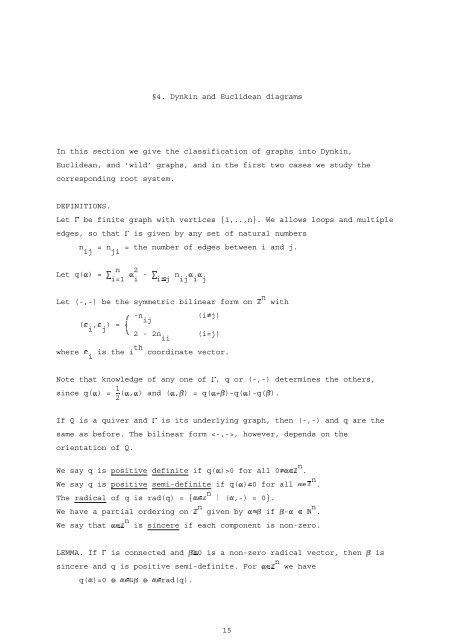Lectures on Representations of Quivers by William Crawley-Boevey ...
Lectures on Representations of Quivers by William Crawley-Boevey ...
Lectures on Representations of Quivers by William Crawley-Boevey ...
You also want an ePaper? Increase the reach of your titles
YUMPU automatically turns print PDFs into web optimized ePapers that Google loves.
§4. Dynkin and Euclidean diagrams<br />
In this secti<strong>on</strong> we give the classificati<strong>on</strong> <strong>of</strong> graphs into Dynkin,<br />
Euclidean, and ’wild’ graphs, and in the first two cases we study the<br />
corresp<strong>on</strong>ding root system.<br />
DEFINITIONS.<br />
Let be finite graph with vertices {1,..,n}. We allows loops and multiple<br />
edges, so that is given <strong>by</strong> any set <strong>of</strong> natural numbers<br />
n = n = the number <strong>of</strong> edges between i and j.<br />
ij ji<br />
i¤<br />
n 2<br />
i=1 i j ij i j<br />
Let q(¤ ) = ¤ ¤ - ¤ n ¤¢¤<br />
n<br />
Let (-,-) be the symmetric bilinear form <strong>on</strong> ¦ with<br />
§ ¨©<br />
(i£ -n<br />
ij<br />
( , ) =<br />
i j<br />
2 - 2n<br />
ii<br />
j)<br />
(i=j)<br />
where<br />
i<br />
th<br />
is the i coordinate vector.<br />
Note that knowledge <strong>of</strong> any <strong>on</strong>e <strong>of</strong> , q or (-,-) determines the others,<br />
1<br />
since q(¤ ) = (¤ ,¤ ) and (¤ ,¥ ) = q(¤ +¥ )-q(¤ )-q(¥ ).<br />
2<br />
If Q is a quiver and is its underlying graph, then (-,-) and q are the<br />
same as before. The bilinear form , however, depends <strong>on</strong> the<br />
orientati<strong>on</strong> <strong>of</strong> Q.<br />
n<br />
We say q is positive definite if q(¤ )>0 for all 0£ ¤ ¡ ¦ .<br />
n<br />
We say q is positive semi-definite if q(¤ )£ 0 for all ¤ ¡ ¦ .<br />
n<br />
The radical <strong>of</strong> q is rad(q) = {¤ ¡ ¦ ¢ (¤ ,-) = 0}.<br />
n n<br />
We have a partial ordering <strong>on</strong> ¦ given <strong>by</strong> ¤¦¤ ¥ if ¥ -¤ ¡ £ .<br />
n<br />
We say that ¤ ¡ ¦ is sincere if each comp<strong>on</strong>ent is n<strong>on</strong>-zero.<br />
LEMMA. If is c<strong>on</strong>nected and ¥¦£ 0 is a n<strong>on</strong>-zero radical vector, then ¥ is<br />
n<br />
sincere and q is positive semi-definite. For ¤ ¡ ¦ we have<br />
q(¤ )=0 ¢¤ ¡¢¡ ¥ ¢¤ ¡ rad(q).<br />
15

















